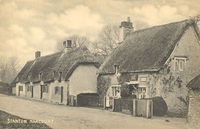Annotation:Nightingale (5) (The)
X:1 T:The Nightingale [5] M:6/8 C: S:Bacon N: A:Stanton Harcourt O:English R:Jig K:G I:speed 300 P:A |:D| G>GD G2A| B>BA B2 G/2c/2 | d>Bd c>BA | G3- G2 :| P:B |: B/2c/2 | d>dB c2 B/2c/2 | d>GA D2 E/2F/2 | G>AB c>de | d>cB c>BA | B>AG A2 D/2D/2 | GBD c>BA | G3- G2 :|
NIGHTINGALE [5], THE. English, Morris Dance Tune (6/8 time). G Major. Standard tuning (fiddle). AABB. The tune, collected from the Cotswold village of Stanton Harcourt, Oxfordshire, may be a variation of "Nightingale (4) (The)" as there are some melodic similarities. The second strain, as printed by Bacon, has seven measures.

Stanton Harcourt, some 5 miles from Oxford, takes its name from the manor of the Harcourt family, originally of Norman extraction. The morris dances were collected in the 2nd half of the 19th century, largely from interviews with the elderly Joseph Goodlake (1836-1901), one of fourteen children born to Sutton publican George Goodlake (his brothers may also have been dancers), who described the village dances. The primary musical source was pipe-and-tabor player John Potter (1813-1892), also a fiddler, who played for several morris sides in the county. It was said that his skill with the pipe was legendary--"He could almost make un speak!" [1] (P. Manning, Folklore, (Seasons). 11, MS Top. axon. d200, p. 238).

